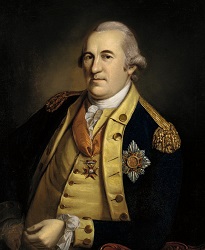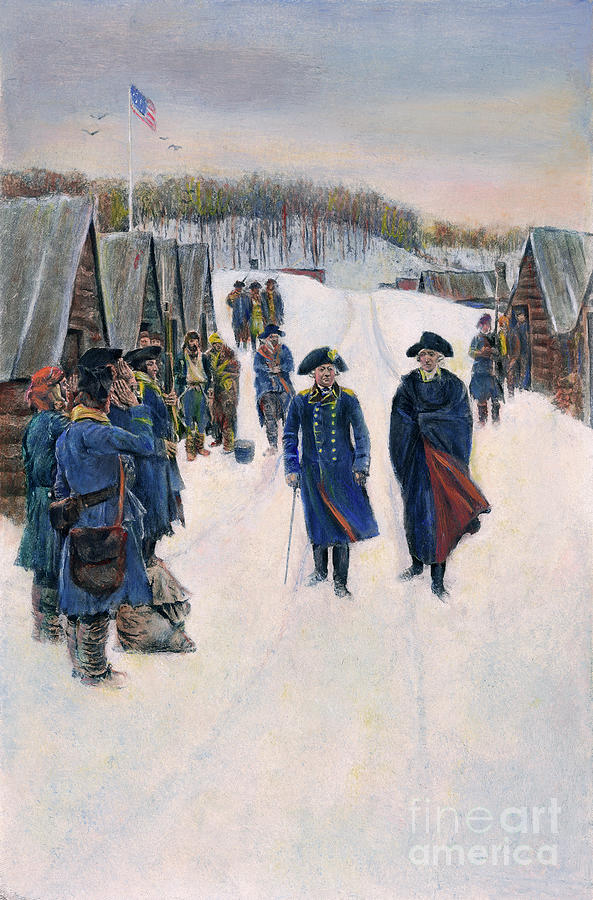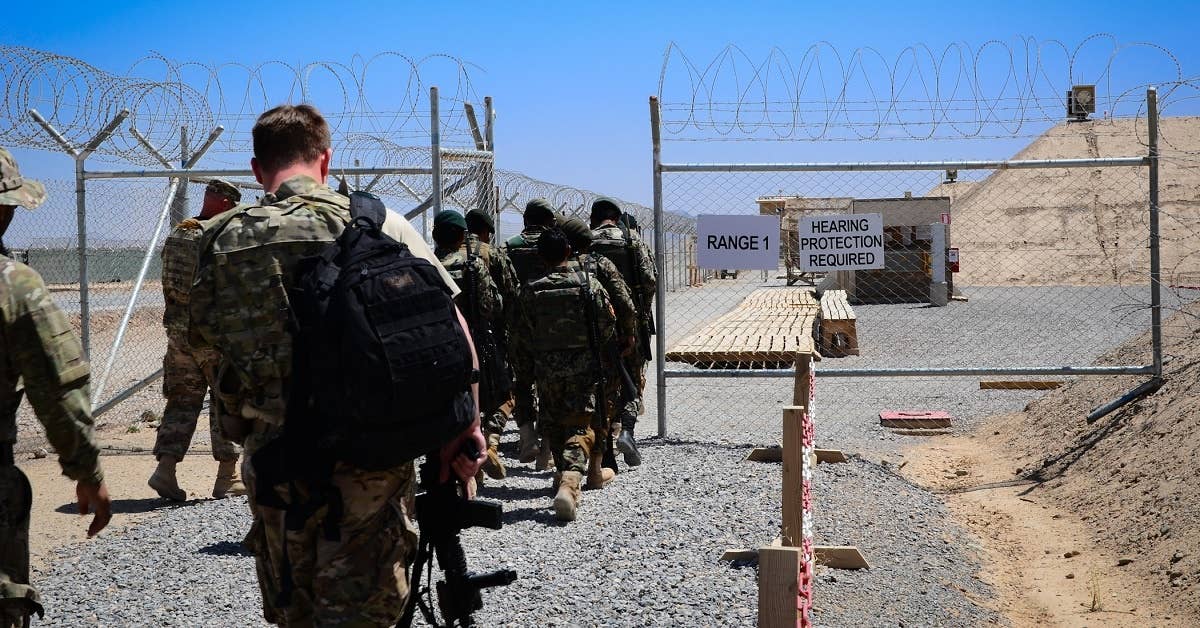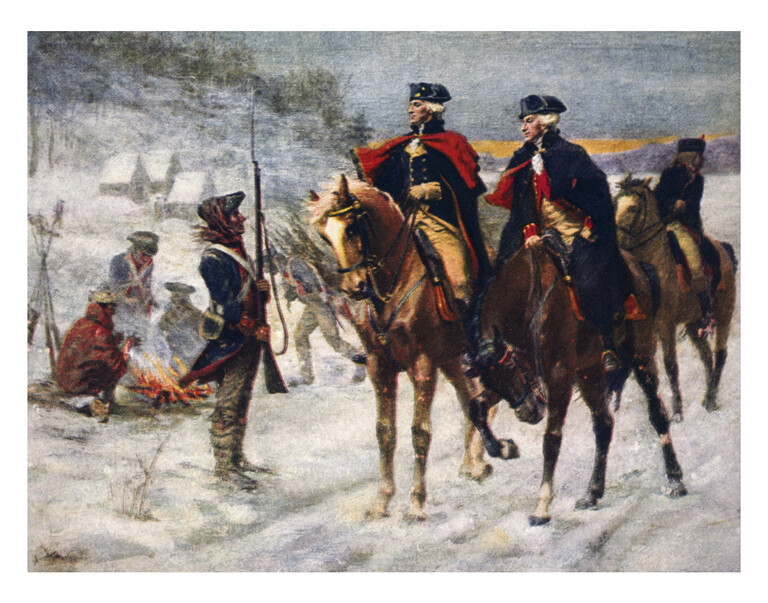Category: Soldiering
Para Reg Old Boys

Baron Friedrich Wilhelm von Steuben
by Charles Wilson Peale, 1780
Von Steuben was born in Magdeburg fortress where his father was an engineer lieutenant in the military in 1730. Most of his adolescent years were spent in Russia, but with his father at the age of 10, they returned to Germany. He was schooled in Breslau by Jesuits and by the age of 17…was a Prussian officer in the military. He was a member of an infantry unit and a staff officer in the Seven Years War, later being made a member of the General Staff serving in Russia periodically. His service was commendable enough that he was eventually given assignment with Frederick the Great’s headquarters.
His experiences as a General Staff member in the Prussian Army gave him a wealth of knowledge that heretofore was unheard of, even in the British and French armies of the period. His training would eventually bring to the American soldiers the technical knowledge necessary to create an army.
At the age of 33, in 1763, Steuben was discharged as a captain from the army, for reasons that are only speculative. The following year he received his “Baron” title when he became chamberlain at the Petty Court of Hohenzollern-Hechingen. He was the only courtier to accompany his incognito prince to France in 1771, hoping to borrow money. Failing to find funds, they returned to Germany in 1775, deeply in debt. Looking for work to reverse his fortunes, von Steuben tried employment in several foreign armies including Austria, Baden and France. He discovered that Benjmin Franklin was in Paris and that possibly, he could find work with the Continental Army in America.
Steuben traveled to Paris in the summer of 1777. As luck would have it, he was endorsed for service by the French Minister of War (Count de St. Germain) who fully realized the potential of an officer with Prussian General Staff training. Steuben was introduced to General Washington by means of a letter from Franklin as a “Lieutenant General in the King of Prussia’s service,” a certain exaggeration of his actual credentials. He was advanced travel funds and left Europe from Marseilles.
On September 26th, 1777, he reached Portsmouth, New Hampshire and by December 1st, was being extravagantly entertained in Boston. Congress was in York Pennsylvania, after being ousted from Philadelphia for the winter and on February 5, 1778, Steuben was with them.
They accepted his offer to volunteer, without pay for the time, and on the 23rd of the same month, Steuben was reporting for duty to General Washington at Valley Forge. Steuben did not speak English, but his French was such that he could communicate with some of the officers. Washington’s aide-de-camp, Alexander Hamilton as well as Nathanael Greene were a great help in this area. The two men assisted Steuben in drafting a training program for the soldiers which found approval with the Commander-in-Chief in March.
How did the men at Valley Forge become an army? Steuben began with a “model company,” a group of 100 chosen men and trained them…they in turn successively worked outward into each brigade. Steuben’s eclectic personality greatly enhanced his mystique.
He trained the soldiers, who at this point were greatly lacking in proper clothing themselves, in full military dress uniform, swearing and yelling at them up and down in German and French. When that was no longer successful, he recruited Captain Benjamin Walker, his French speaking aid to curse at them FOR HIM in English.
His instructions and methods have a familiar ring, nor is this strange when we consider that much of what is done today stems from his teachings. To correct the existing policy of placing recruits in a unit before they had received training, Von Steuben introduced a system of progressive training, beginning with the school of the soldier, with and without arms, and going through the school of the regiment. Each company commander was made responsible for the training of new men, but actually instruction was done by selected sergeants, the best obtainable.
Warfare in the Eighteenth Century was a comparitively simple matter, once the battle was joined. Combat was at close range, massed-fire melee, where rapidity of firing was of primary importance. Accuracy was little more than firing faster thatn the opposing line. Much of the Regulations dealt with the manual of arms and firing drills. But battle was close-order drill, and speed of firing could only be obtained by drilling men in the handling of their firearms until the motions of loading and firing were mechanical. Firing was done in eight counts and fifteen motions.
Fire! One Motion.
Half-Cock — Firelock! One Motion.
Handle — Cartridge! One Motion.
Prime! One Motion.
Shut — Pan! One Motion.
Charge with Cartridge! Two motions.
Draw — Rammer! Two motions.
Ram down — Cartridge! One Motion.
Return — Rammer! Two motions.
Complicated as they seem, the new firing regulations were much simpler than those used by foreign armies and they speeded up firing considerably. The bulk of the fighting in the Revolutionary War was a stand up and slug match. The winning side was the one that could get in a good first volley, take a return fire and re-load faster than its foes. Once the individual could handle himself and his musket he was placed in groups of three, then in groups of twelve, and taught to wheel, to dress to the right and to the left. Alignment and dressing the ranks was emphasized but only because proper alignment was necessary for smooth firing.
Another program developed by Steuben was camp sanitation. He established a standards of sanitation and camp layouts that would still be standard a century and a half later. There had previously been no set arrangement of tents and huts. Men relieved themselves where they wished and when an animal died, it was stripped of its meat and the rest was left to rot where it lay. Stueben laid out a plan to have rows for command, officers and enlisted men. Kitchens and latrines were on opposite sides ot the camp, with latrines on the downhill side. There was the familiar arrangement of company and regimental streets.
The results of the army training were in evidence by May 20, 1778 at Barren Hill and then at Monmouth (ending June 28th). Washington recommended an appointment for Steuben as Inspector General on April 30th, and on May 5th, Congress approved it. It was Steuben serving in Washington’s headquarters in the summer of 1778 who was the first to report the enemy was heading for Monmouth. During the winter of 1778-1779, Steuben prepared “Regulations for the Order and Discipline of the Troops of the United States,” also known as the “Blue Book.” It’s basis was the plan he devised at Valley Forge.
The following winter (1779-1780) his commission was representing Washington to Congress regarding the reorganization of the army. He later traveled with Nathanael Greene-the new commander of the Southern campaign.
He quartered in Virginia since the American supplies and soldiers would be provided to the army from there. He aided the campaign in the south during the spring of 1781, culminating in the delivery of 450 Virginia Continentals to Lafayette in June. He was forced to take sick leave, rejoining the army for the final campaign at yorktown. At Yorktown his role was as commander of one of the three divisions of Washington’s troops.
He gave assistance to Washington in demobilizing the army in 1783 as well as aiding in the defense plan of the new nation. He became an American citizen by act of Pennsylvania legislature in March 1784 (and later by the New York authorities in July 1786). He was discharged from the military with honor on March 24, 1784.
He established residency in New York where he became a very prominent figure. His business acumen was not very keen, and he found himself in difficult financial condition once more. The primary reason was most likely the fact he was living off the prospect of financial compensation from the United States government which was unrealized until June of 1790 when he was granted a yearly pension of $2,500.
His financial problems were not ironed out until Alexander Hamilton and other friends helped him gain a “friendly” mortgage on the property he was given in New York (about 16,000 acres). He died a bachelor in 1794, leaving his property to his former aides, William North and Benjamin Walker.
Much of the captured equipment, was incorporated into the Wehrmact, especially vehicles. Many of the trucks used during the invasion of Russia in 1941 were of French manufacture, & would continue to be produced in occupied French factories until liberation. German use of captured/confiscated equipment would become standard practice, & continue until the end of the war. In fact German use of foreign equipment was already under way before the war started.
The Wehrmact already utilized much first class equipment taken from Czechoslovakia whenever they occupied that country in 1938–39,especially weaponry such as the 38t tank, the ZB 26 & ZB 37 MGs,as well as optical instruents. The excellent Belgian made FN Browning “Hi Power” pistol continued in production in occupied Belgium throughout most of the war & large numbers were issued to the German military, especially the Waffen SS.
Not only vehicles & weaponry, but captured stocks of clothing were also utilized. Czech Army helmets were re-issued to German civilian organizations such as air raid wardens & the Fire Police. Kriegsmarine personelle, especially U Boat crews were often issued with British Army battle blouses,taken from large British stocks captured in 1940. French Army tropical shirts captured in 1940 saw widespread service by the Afrikakorps in North Africa as well. Even food was requisitioned, much taken after the fall of Tobruk in 1942. Canned British corned beef & canned fruit being especially prized.
A lot of Russian artillery was utilized by the Germans, the 76mm M1936 F22 anti tank gun for example, as well as captured T 34 tanks & small arms throughout the war on the Eastern Front. In North Africa, the Afrika Korps used captured British vehicles in large numbers. When Italy left the Axis in 1943, the Germans seized much Italian military equipment including vehicles, aircraft, & especially large stocks of cloth for the manufacture of uniforms. Much of the German weaponry used along the “Atlantik Wall” in France was of Czech, French, & Russian manufacture, even Polish machine guns were utilized. Germany received a second infusion of French equipment whenever it occupied the the remainder of France from Vichy in 1942.
Spare parts for vehicles, & as the war progressed, fuel, would become a problem for certain vehicles over time, but many vehicles ( as well as some aircraft, such as the Ju 52, & Fiesler Fi 56 “Storch”) continued to be produced in factories in occupied countries such as France & Czechoslovakia until the end of the war. Ammunition for captured weaponry could be produced in German factories, or sometimes the weapons converted to German calibers.
Captured British Battle Blouse taken from captured British stocks in France in 1940, & reissued to U Boat personelle, has removable German buttons, & German insignia added. (Collectors Weekly)
The excellent Belgian made 9mm “Hi Power”pistol. Large numbers were confiscated by the Germans after Belgium’s surrender in 1940. Large numbers continued to be produced in Belgian factories & issued to the German military. (Simpson Lmtd)
German soldier with Belgian Browning Hi Power 9mm pistol.
French M29 Light MG. Many of these weapons captured in 1940 were issued to German rear area security & Police units in Russia & Yugoslavia for use against partisan units.. (Rock Island Auction)
German soldier manning French made Hotchkiss MG along the Atlantic coast. (Bundarchv).
Renault AHR trucks. Not only did the Germans utilize captured trucks, they continued to manufacture the vehicles in the Renault factory in occupied France.
Captured Soviet T 34.
Captured British Ford truck, North Africa.
Waffen SS “M 43” field cap made from Italian military “Trikot” cloth . Large stocks of Italian cloth were seized by the Germans, after the Italian armistace in 1943, including camouflage, & used by the Germans in uniform manufacturing . (Collectors Guild)
Waffen SS officers wearing tunics & trousers made from Italian Army camouflage clothing material, large stocks of which were seized after the Italian armistace in 1943.

Deploying is just one of those things every troop knows will happen eventually. There are two ways troops look at this: Either they’re gung-ho about getting into what they’ve been training to do for years or they’re scared that they’ll have to do what they’ve been training years to do for years. No judgement either way, but it’s bound to happen.
The truth is, combat only makes up a fraction of a fraction of what troops do while deployed. There are some troops who take on an unequal share of that burden when compared to the next, but everyone shares some of the same downsides of deployment.
Today’s troops have it nicer than those that came before them and some units may inherently have an easier time of things. Still, everyone has to deal with the same smell of the “open air sanitation pits” that are lovingly called “sh*t ponds.”

Yep. And the VA is still debating whether this is unhealthy or not.
(Photo by Sgt. 1st Class Erick Studenicka)
Sanitation
Speaking of open pits of disposed human filth that are totally not going to cause health problems down the road, the rest of your deployment won’t be much cleaner.
Sand will get everywhere no matter how many times you sweep. Black mold will always creep into your living areas and cause everyone to go to sick call. That’s normal.
What’s not normal is the amount of lazy, disgusting Blue Falcons that decide that using Gatorade bottles as piss pots is more convenient than walking their ass to a proper latrine but get embarrassed by their disgusting lifestyle so they horde that sh*t under their bunk in some sick, twisted collection. True story.

That is, if you can get to an uncrowded USO tent to actually talk to your folks back home.
(U.S. Navy photo by Petty Officer 1st Class Jonathan Carmichael)
OPSEC
Everyone knows they’re going to have to be away from their family, but no one really prepares you for the moments when you’re going to have to tell them you can’t talk a few days because something happened — “Comms Blackouts.” They’re totally normal and it freaks out everyone back home. it’s up to the troops to explain the situation without providing any info that would incur the wrath of the chain of command.
We’ve all heard the constant, nebulous threats. “The enemy is always listening!” “All it takes is one puzzle piece to lose the war!” Such concerns aren’t unfounded — and it leaves troops clammed up, essentially without anything interesting to talk about while deployed.

I’m just saying, we’re doing you a favor by not saluting you where there could be snipers…
(U.S. Marine Corps photo by Cpl. Alejandro Pena)
Other units’ officers
Every unit falls under the same overarching rules as set forth by the Uniform Code of Military Justice. So, if someone’s doing something that breaks said code, any troop can (and should) step in to defuse the situation. That being said, every unit functions on their own SOPs while downrange and there’s always going to be a smart-ass butterbar who raises hell about not being saluted in a combat zone.

Don’t worry, though. This guy will probably have a a “totally legitimate” copy of all the seasons of ‘Game of Thrones’ on DVD.
(Official Marine Corps Photo by Eric S. Wilterdink)
Everything you’re going to miss out on
Being deployed is kind of like being put in a time capsule when it comes to pop culture. Any movie or television show that you would normally be catching the night of the release is going to end up on a long checklist of things to catch up on later.
To make matters worse, troops today still have an internet connection — just not a very good one. So, if some big thing happened on that show you watch, it’s going to get spoiled eventually because people assume that, after a few weeks, it’s all fair game to discuss. Meanwhile, you’re still 36 weeks away from seeing it yourself.

You’d think this isn’t comfy. But it is.
(U.S. Army)
Sleep (or lack thereof)
Some doctors say that seven to nine hours of sleep are required for the human body to function. You will soon laugh in the face of said doctors. You’ll be at your physical peak and do just fine on five hours of constantly interrupted sleep.
War is very loud and missions occur at all hours of the day. What this means is just as soon as you get tucked in for the night, you’re going to hear a chopper buzz your tent while a barely-working generator keeps turning over which is then drowned out by the sounds of artillery going off. Needless to say, when the eventual IDF siren goes off, you’ll legitimately debate whether you should get out of bed or sleep through it.

Ever wonder why so many troops make stupid films while in the sandbox? Because we’re bored out of our freakin’ minds!
Boredom
The fact that you’re actually working 12-hour days won’t bother you. The fact that you’re going to get an average of five hours of sleep won’t bother you. Those remaining seven hours of your day are what will drive you insane.
You could go to the gym and get to looking good for your eventual return stateside. You could pick up a hobby, like learning to play the guitar, but you’d only be kidding yourself. 75 percent of your time will be spent in the smoke pit (regardless if you smoke or not) and the other trying to watch whatever show is on at the DFAC.

“Oh, look! It seems like everyone came back from deployment!”
(U.S. Army)
All that money (and nothing to spend it on)
Think of that episode of The Twilight Zone where the world’s end comes and that one dude just wants to read his books. He finally finds a library but — plot twist — he breaks his glasses and learns that life is unfair. That’s basically how it feels when troops finally get deployment money. It’ll be a lot more than usual, since combat pay and all those other incentives are awesome, but it’s not like you can really spend any of it while in Afghanistan.
If you’re married, that money you’re be making is going to be used to take care of your family. Single troops will just keep seeing their bank accounts rise until they blow it all in one weekend upon returning.

